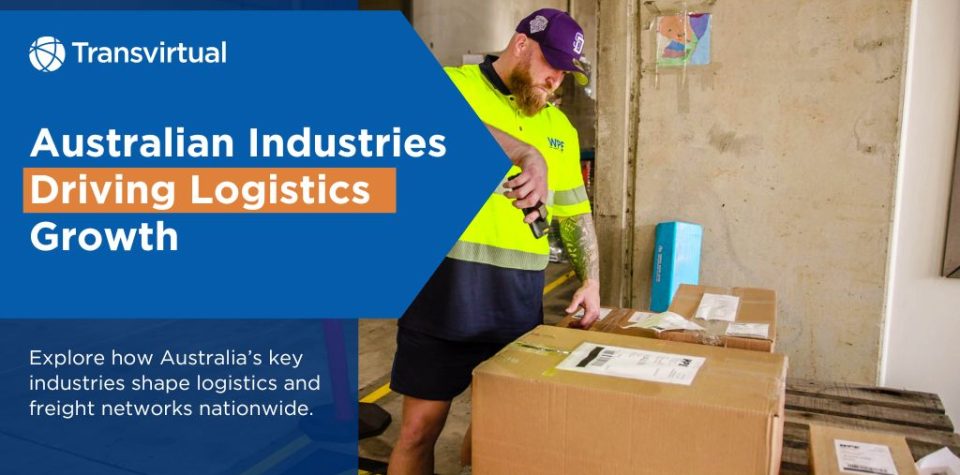Table of Contents
In our previous article, we looked at how each state moves freight, from NSW’s busy road and rail networks to Western Australia’s long-haul export corridors. This next piece focuses on the industries behind those movements, aka the sectors powering Australia’s economy, shaping demand, and driving business operations nationwide.
Across mining, agriculture, construction, retail, and health care, industries are evolving fast. New technology, rising costs, and global market pressures are changing how businesses plan, hire, and move goods. With continued growth across multiple sectors and the Australian Government pushing for renewable energy and net zero emissions, logistics networks are adapting to support a stronger, more sustainable economy.
By the end of this post, readers will gain a clear picture of the link between industries, logistics, and economic growth, helping business leaders, logistics operators, and investors make informed decisions.
Logistics by the Numbers: Australia’s Key Industry Sectors Driving Growth
1. Mining and Resources
Mining remains to be a key figure in the Australian industry, especially in Western Australia and Queensland. Iron ore, coal, natural gas, and critical minerals dominate exports, linking regional areas to international markets through strong rail and sea freight infrastructure.
Main Freight Modes: Rail and sea freight
What to Watch: Volatile commodity prices, higher input costs, and the renewable energy transition are reshaping mining operations. Expect increased reliance on data analytics, automation, and higher skilled roles as companies invest in sustainable practices and technical services to stay competitive.
Mining remains to be a key figure in the Australian industry, especially in Western Australia and Queensland. Iron ore, coal, natural gas, and critical minerals dominate exports, linking regional areas to international markets through strong rail and sea freight infrastructure.
2. Agriculture and Food Exports
Agriculture continues to be one of Australia’s fastest-growing industries. From premium beef and grain to dairy and fresh produce, the sector connects local farms to new international markets, particularly across Asia. Tasmania and New South Wales stand out for food exports supported by cold chain logistics, e-commerce, and digital technologies.
Main Freight Modes: Road, rail, and sea freight
What to Watch: Growing demand for temperature-controlled transport, increased spending on logistics innovation, and data-driven operations that improve food quality and reduce waste. Businesses are adapting to global trends while balancing input costs, workforce challenges, and environmental goals.
3. Manufacturing and Construction
Manufacturing and the construction industry are central to the Australian economy. They provide jobs and are paramount to fortifying the country’s infrastructure. These sectors rely on wholesale trade, transport, and professional services, and they drive growth through investment, innovation, and new technologies.
Main Freight Modes: Road and rail freight
What to Watch: Skills shortages and rising costs continue to challenge companies, but technological advancements and cyber security solutions are opening new opportunities. Expect increased training, higher skilled roles, and the adoption of data analytics to improve efficiency, safety, and project delivery.
4. eCommerce and Retail
Retail trade has evolved rapidly over the past year. Consumer expectations, online shopping, and faster delivery demands are reshaping supply chains nationwide. Fulfilment networks in Victoria and New South Wales are expanding, supported by investments in automation and warehouse development.
Main Freight Modes: Road and air freight
What to Watch: Growing demand for smarter inventory systems, cyber security, and integrated digital technologies (like an end-to-end Freight Management System). As eCommerce expands, companies are using analytics to improve operational visibility, manage increased spending, and strengthen financial performance across logistics networks.
5. Health Care, Pharmaceuticals, and Social Assistance
Health care and social assistance are projected to be among the fastest-growing industries over the next decade. Victoria’s pharmaceutical exports and Melbourne’s position as a biotech hub are driving new markets for research, healthcare services, and advanced manufacturing.
Main Freight Modes: Air and road freight
What to Watch: Growth in healthcare, education, and research is driving stronger demand for temperature-controlled logistics, secure data systems, and reliable last-mile delivery for medical supplies and pharmaceuticals. As digital health systems and cyber security become more advanced, logistics providers will need to meet strict compliance and traceability standards.
Continued focus on sustainability and renewable energy will also influence how fleets, warehouses, and cold chain operations are managed across the sector.
The Importance of Targeting the Right Industry for Growth
For transport providers, growth begins with understanding where demand comes from. Each major industry, from mining and agriculture to construction, retail, and health care, influences how freight moves across Australia. The closer you understand those connections, the stronger your network, pricing, and partnerships become.
The next decade will test how well logistics businesses adapt to changing markets, new technology, and shifts in the labour market. Those that follow industry trends and align their operations with Australia’s economic direction will lead a more efficient, resilient, and connected supply chain.
Each major industry, from mining and agriculture to construction, retail, and health care, influences how freight moves across Australia. The closer you understand those connections, the stronger your network, pricing, and partnerships become.
Each major industry, from mining and agriculture to construction, retail, and health care, influences how freight moves across Australia. The closer you understand those connections, the stronger your network, pricing, and partnerships become.
How Transport Providers Can Stay Ahead with Transvirtual
Understanding industry trends is only half the battle. The other half is having real-time visibility, data insights, and tools to act on that information.
Transvirtual connects freight operations with the industries driving demand, helping businesses:
Track shipments across the country.
Align capacity and resources with industry-specific freight patterns.
Use data analytics to forecast demand, reduce delays, and optimise routes.
Monitor performance and costs in real time to make informed decisions.
By linking operational data with industry insights, transport providers can make smarter decisions, stay agile, and respond quickly to changes in demand, all without adding extra complexity to their workflow.
Frequently Asked Questions
By analysing sector-specific freight patterns, providers can allocate vehicles, warehouse space, and staff more efficiently. For example, mining exports rely heavily on rail and sea, while e-commerce spikes require flexible last-mile delivery strategies.
Health care, pharmaceuticals, and social assistance are expanding rapidly. Temperature-controlled shipments, secure data handling, and timely deliveries are increasingly critical. Agriculture and premium food exports also drive demand for cold chain and cross-border logistics.
Digital logistics platforms improve visibility, scheduling, and route optimisation. Integrating cyber-secure software allows providers to track shipments in real time, manage compliance, and respond quickly to industry-specific challenges.
Knowing which sectors drive demand helps providers forecast volumes, select the right freight modes, and plan capacity. This reduces dead runs, improves delivery reliability, and positions businesses to capitalise on growth opportunities.

